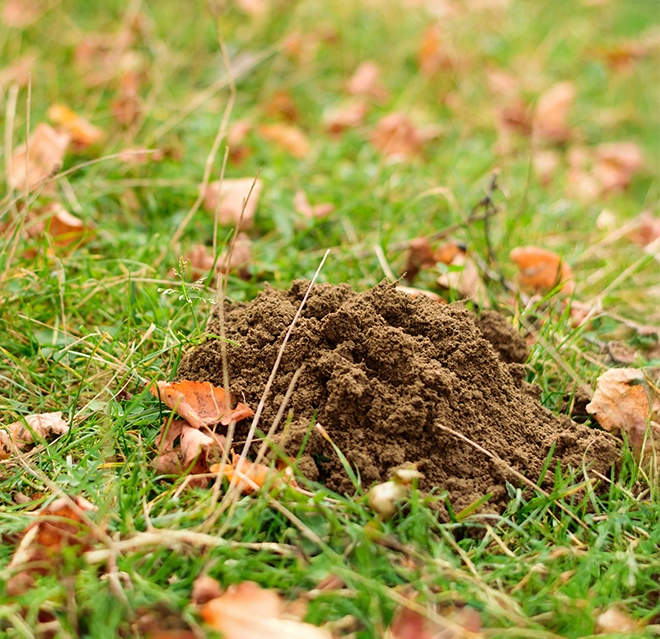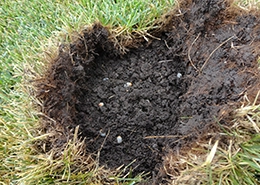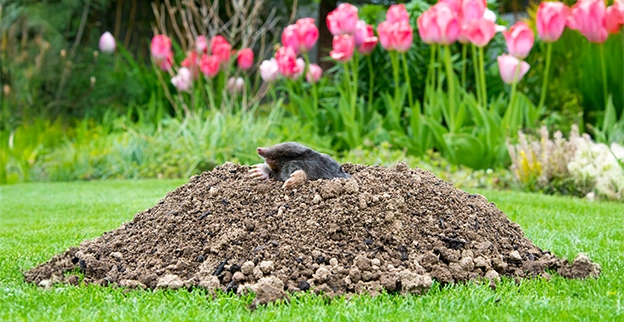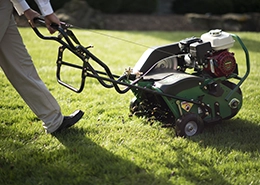When it comes to lawn care, Lawn Pride® has seen it all. From pesky voles to elusive moles, our experienced team knows how to remove underground nuisances that undermine the look of your lawn. With proven techniques and eco-friendly solutions, we ensure your lawn remains pristine and mole-free.
Our Mole Control Service: What to Expect

What is Lawn Pride’s lawn control method?
Some lawn services provide mole extermination. We take a humane, non-lethal approach to mole control. We take time to map out the mole’s runways and strategically place bait where they’ll be tempted to eat. This bait agitates but doesn’t kill the moles. Instead, the irritated moles will typically leave your yard for a more hospitable place to live.
A healthy lawn is a mole-free lawn. After we evict these pests, you can make your property less inviting by eliminating hiding places. Regular mowing and removing ground cover such as weeds, leaves, and dead grass can do wonders for mole prevention. By keeping your property free of debris, you minimize the odds of more moles moving onto your property.

Keep Your Property Free of Moles With Lawn Pride
Ready to reclaim your lawn from destructive moles? Say goodbye to unsightly tunnels and damaged roots with our professional mole control services. Your local Lawn Pride team effectively roots out moles while safeguarding the health of your lawn.
Don't let mole infestations compromise the beauty of your outdoor space any longer. Contact us today to schedule your mole control service and take the first step towards a lush, healthy, mole-free lawn. Get a free estimate now!

Our Special Offers
We understand your goal to keep your lawn looking its best. We take pride in your lawn because we know you do, too. Check out our special offers to see how you can save on your next lawn care application.
Mole Control Services
Once moles invade your yard, they can cause significant damage to your lawn and plants. Prompt action from an experienced mole removal service professional is essential to prevent further damage and keep your lawn and plants healthy and thriving.
Count on your local Lawn Pride team for mole service solutions that work every time.
Other services we provide include:
-
-

Grub Control
Learn More Grub ControlWe apply targeted insecticides or pesticides that specifically target larvae or nymphs.
-

Fertilization
Learn More FertilizationWe use targeted fertilization treatments throughout the year.
Customer Reviews
View All Reviews
The Neighborly Done Right Promise® delivered by LawnPride®, a proud Neighborly company.
FAQ About Mole Control Services
Many property owners have questions about Lawn Pride’s services when they have lawn pest infestations. We’ll gladly answer all your questions before scheduling service and during our visit to your home. Below are answers to some of the most frequently asked questions we receive about our mole removal service. You can always contact us if you have more questions:

Join Our Team
“We have the power to make things better.” That’s our mantra, not only for our customers' lawn issues, but also you, a future team member! At LawnPride, we provide a career path for growth and treat you like family. They know that a happy, motivated team is key to serving customers well. That's why we value integrity and respect and create a strong work ethic.

